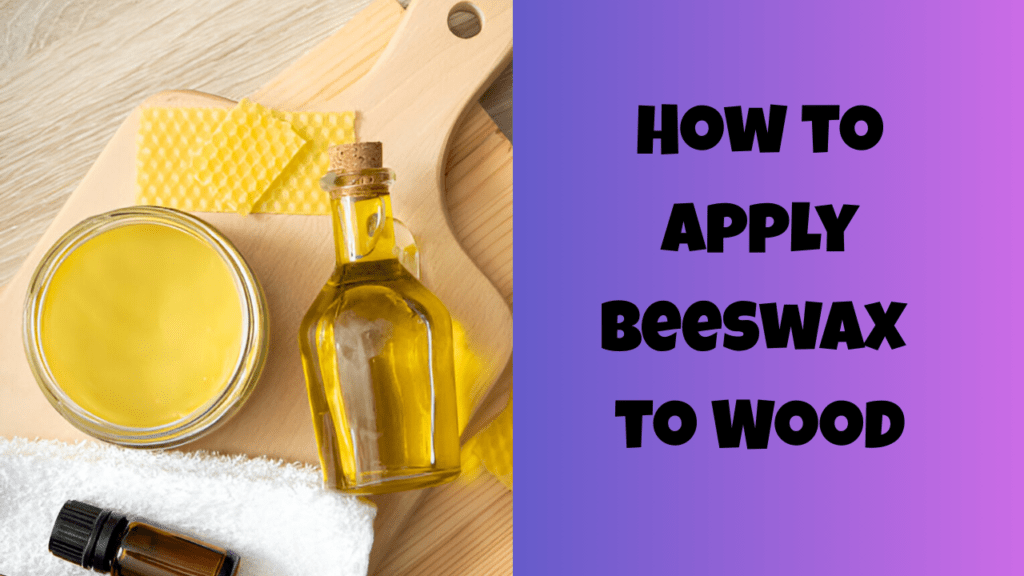
Wood has been a popular material in furniture making and construction for a long time because of its natural beauty and warmth. Whether you’re building new furniture or fixing old wooden surfaces, the finish you choose can really affect how it looks and how long it lasts. Among many options, beeswax wood finish is special for its natural qualities and beauty.
Benefits of using beeswax wood polish and preserver:
It gives a shiny finish.
Beeswax wood polish works just as well as other commercial products in bringing out the natural beauty of wood. Unlike some wood polishes that can change the color or look of the wood, beeswax gives the wood a smooth and shiny finish.
It turns dry and dull wood into a warm, glowing surface. In contrast, varnish, which is made from resin, can make the wood look old and dry.
It’s natural.
One of the best things about beeswax is that it’s natural. It makes your wooden furniture look nice without releasing harmful chemicals into the air, which can cause pollution.
Since beeswax is often used in skin products like moisturizers and lip balms, it’s gentle on your skin and safe to touch. Beeswax helps reduce pollution, which is good for the environment, as Sara Snow explains in her book, “Sara Snow’s Fresh Living.”
It lasts a long time.
Beeswax is good at protecting wood. It contains high-carbon paraffin, which nourishes the wood and protects it from moisture and sunlight. This is especially important for furniture placed near windows or doors, where it can get damaged by rain or wind.
Unlike varnish, which only coats the surface, beeswax actually soaks into the wood, making it more durable. While beeswax needs to be reapplied more often than other finishes like varnish, it can last longer when used on top of another finish.
It’s Food Safe.
Beeswax is safe to use on things like wooden salad bowls and chopping boards because it’s safe to eat. Although we don’t usually eat directly from these surfaces, food often touches them, so it’s important to use a non-toxic product.
Beeswax is also safe for wooden toys, which is important because children sometimes chew on toys. Unlike chemicals that can harm your skin or eyes, beeswax is safe and gentle.
It’s affordable.
Beeswax is easy to find and inexpensive. You can make your own beeswax wood polish with just a few simple, safe ingredients. This can save you money compared to buying commercial products.
Plus, making your own beeswax polish can give you the satisfaction of knowing exactly what’s in it and that you’re using something safe for the environment and your health.
How to Apply Beeswax to Wood
Before applying beeswax, it’s important to clean the wooden furniture first. Use a dry cloth to wipe off any dirt or grime from the surface. If needed, you can dampen the cloth to remove stubborn dirt, but make sure the surface is dry before you start applying the beeswax.

Steps to Apply Beeswax:
Start from one corner:
Dip a cloth into the beeswax and apply it in a straight line, starting from one corner of the wood. For example, if you’re working on a tabletop, start at one corner and move across the table in a single stroke.
Work in sections:
Keep rubbing the wax across the wood, re-dipping the cloth in the wax when needed. Make sure the wax gets into all the crevices and evenly covers the surface.
Drying time:
Beeswax dries quickly. Check the drying time for the brand you are using. Wait for the wax to dry before you proceed to the next step.
Buff the surface:
Once the wax has dried, take a dry cloth and buff the surface. This will give the wood a smooth, dull yellow, leathery finish.
Applying Multiple Coats:
When applying beeswax for the first time, it’s best to use at least two to three coats. Wait about three to four hours between coats to allow the wax to dry completely.
Tips to Remember:
Beeswax meant for floors should not be used on other types of wooden furniture. Always buy wax that is specifically made for furniture.
Let the beeswax dry completely before buffing. Buffing while the wax is still wet will just spread it around without giving the desired finish.
By following these simple steps, your wooden furniture will look polished and protected with a beautiful finish.
Also read:
Wood Finishes 101: Make the Right Choice for your project !
How to Make Beeswax Polish at Home
You can easily make beeswax polish at home by mixing beeswax and oil in a ratio of 1:4. You can use different types of oils such as jojoba oil, coconut oil, olive oil, or walnut oil. Here’s how to make it:
Prepare the Beeswax:
Grate the beeswax or crush it into small pieces.
Mix with Oil:
Take one cup of oil and add the grated beeswax to it.
Heat the Mixture:
Heat the mixture on the stove. Stir it continuously to ensure the beeswax melts and mixes evenly with the oil.
Add Essential Oils (Optional):
Once the mixture is fully dissolved, you can add a few drops of essential oil to give the polish a pleasant fragrance when applied to the wood.
Cool the Mixture:
Let the mixture cool down while stirring it occasionally. This prevents the oil and beeswax from separating. Once it cools, the beeswax polish will become thicker.
Also read:
Teak Oil vs Tung Oil: Which Wood Finish is Best for You?
Boiled Linseed Oil Explained: Uses, Advantages, and Tips
Caring for Beeswax-Finished Surfaces
To keep your beeswax polish fresh and effective, proper storage is essential. Here’s how to care for and store it:
Storage:
Store your homemade beeswax polish in an airtight glass or metal container. Avoid using plastic containers as they may cause the wax to absorb chemical odors over time.
Shelf Life:
The shelf life of your beeswax polish depends on the type of oil used:
- Olive oil: 12 to 18 months
- Coconut oil: 24 months
- Jojoba oil: Up to 5 years
If you plan to make a large batch and store it for a long time, jojoba oil is the most stable option. However, it’s important to check the polish over time.
If it starts to smell like wax or crayon, it may have gone bad. In such cases, it’s best to discard it and make a fresh batch when needed.
By following these simple steps and storing the polish correctly, you can keep your homemade beeswax polish fresh and ready to use.
A COMPARISON OF HEMP OIL, TUNG OIL AND BEESWAX FINISH
| Feature | Beeswax Wood Finish | Oil Finishes | Varnishes & Lacquers | Water-Based Finishes |
| Source | Natural substance produced by honeybees. | Derived from plant or petroleum sources. | Synthetic resin-based formulations. | Water-soluble polymers. |
| Appearance | Enhances natural beauty, adds warmth. | Enhances wood grain, adds depth. | Forms a glossy, protective layer. | Provides clear, matte or glossy finish. |
| Protection | Provides moderate protection against moisture. | Penetrates wood to nourish and protect. | Forms a durable barrier against wear and tear. | Offers durable, water-resistant coating. |
| Application | Applied with a cloth or brush, easy to use. | Requires multiple coats, longer drying time. | Requires careful application to avoid streaks. | Easy to apply, dries quickly. |
| Eco-Friendliness | Biodegradable, derived from renewable resource. | Depends on source, some are eco-friendly. | Often contains VOCs, may emit harmful fumes. | Low VOC content, environmentally friendly. |
| Reapplication Frequency | Every few months for optimal protection. | Periodic reapplication required for maintenance. | Long-lasting, may require refinishing over time. | Periodic maintenance to maintain appearance. |
| Suitability | Suitable for all wood types, enhances natural look. | Suitable for most wood types, versatile. | Ideal for high-traffic areas, indoor use. | Suitable for interior wood surfaces, furniture. |
Conclusion
Beeswax wood polish is a natural and traditional way to protect and shine wooden items like furniture and cutting boards. Made from honeybee wax, it has been used for hundreds of years to show off the beauty of wood and keep it safe without using chemicals.
Beeswax helps protect wood from water, bacteria, and damage like swelling or cracking. It soaks into the wood instead of sitting on top, so the wood can still move without breaking.
Using beeswax polish is simple. You only need beeswax, oil, and a cloth. You can even make your own mix to suit your wood and climate. With some light rubbing, you can build up a smooth, long-lasting shine.
Beeswax is also better for the environment. It’s non-toxic and doesn’t release harmful fumes like some store-bought products.
If you love the natural look of wood, try beeswax polish. It’s safe, eco-friendly, and gives a beautiful, rich shine.
Frequently Asked Questions (FAQ)
1. What is beeswax wood finish?
Beeswax wood finish is a natural product made from beeswax and oil, used to protect and enhance wooden surfaces, providing a glossy, smooth finish.
2. How do I apply beeswax to wood?
Clean the wood, apply beeswax with a cloth in straight strokes, and buff with a dry cloth once dry. Apply 2-3 coats, allowing drying time between each.
3. Can I make beeswax wood finish at home?
Yes, mix beeswax and oil (1:4 ratio), heat until dissolved, cool, and apply. Add essential oils for fragrance.
4. How long does beeswax wood finish last?
Beeswax lasts several months but may need reapplication, especially for high-use furniture.
5. Is beeswax wood finish safe to use?
Yes, it’s non-toxic and safe for use on wood, including kitchen items and children’s furniture.
6. Can I use beeswax on all types of wood?
Yes, but test it on a small area first as different woods absorb beeswax differently.
7. How do I maintain beeswax-finished wood?
Clean with a soft cloth and reapply beeswax every few months or as needed.
8. What should I do if the beeswax finish looks dull or uneven?
Buff the surface or reapply a fresh coat of beeswax.
9. How should I store beeswax wood finish?
Store in an airtight glass or metal container in a cool, dark place.
10. Can beeswax be used on outdoor furniture?
Beeswax is not ideal for outdoor furniture due to wear from the elements. Use a dedicated outdoor finish instead.

